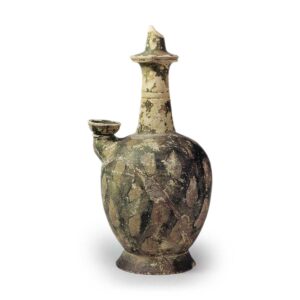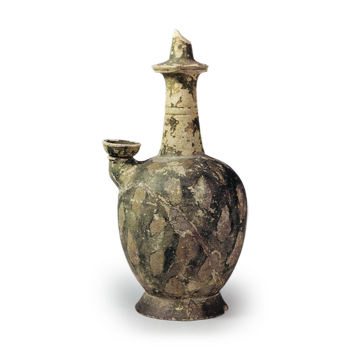
Nisai glazed ware: holy water pitcher.
Excavated from Nanatsuchi Pond, Obarada-cho, Koriyama-shi, Fukushima
8th century
Height 29.0cm, Body diameter 13.4cm, Bottom diameter 9.6cm
Important Cultural Property
Enjuji Temple
From the late Nara to Heian periods, ceramic vessels modeled after the Sabari jovial vessels were widely produced as Buddhist vessels, but this is the only known lead-glazed vase. It was excavated on November 23, 1938, in a large Sue ware jar from the hillside of Nanatsuchi Pond, west of Obarada Town, and was accompanied by a Sue ware water jar, a round-faced inkstone, a small black earthenware jar, and an earthenware steamer. The site is called “Fugendan” in the neighborhood, but the nature of the remains is not clear.
The nisai jyobin was excavated in several pieces, regrettably lacking the edge of the mouth. The base is made of yellowish-white, dense clay, and the lower half of the body is relatively well fired, but the upper half is a little under-fired. The molding is sharply wheel-thrown and neatly shaped. The Sansai glaze pattern is the same as that of the Shosoin Nisai vase, with white glaze scattered in a pattern of baby deer spots, which is exactly the same pattern. The lower half is well fused and dark green in color, but the upper half, especially the neck of the mouth, is thin and the glaze has peeled off remarkably.



